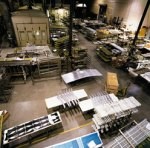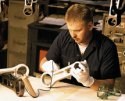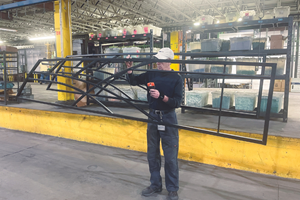Improving Process Control
An imperceptible difference can be substantial depending on the circumstances...
Tenths, even hundredths, of a second can make a vital difference. Just ask any NASCAR driver whose lost "by a nose." A fraction of a milliliter of venom can kill. Just ask any person allergic to bee stings. A little bit can make a big difference in many instances, including finishing. And particularly in the aerospace industry.
By taking a different approach to coating thickness inspection, Hytek Finishes, Kent, WA, has significantly improved throughput and added a new dimension of process control.
Hytek is the largest independent supplier of specialized finishing, anodizing and organic coating services in the Pacific Northwest. More than 60% of the company's business is aerospace related. The remaining 40% includes electronics, industrial and recreational applications.
To meet the needs of the aerospace industry, we developed expertise in finishing technical and high heat-treated parts using coating processes that met stringent prime contractors' certification requirements and Mil specifications. For example, our special aerospace process capabilities include low-embrittlement TiCad plating on steel, hard-coat anodizing to create a hard, machinable surface on aluminum parts such as hydraulic cylinders, including 2000 series alloys, and hard-chromium plating, which is used to improve corrosion resistance and wearability of struts, bolts, landing gear pins and high heat treat parts.
The 93,000-sq-ft facility stays busy. We process up to 250 individual orders per day. With so many different coating and plating jobs moving through the facility at the same time, turnaround is critical. In a business where quality is of primary importance, the quality control aspect of production figures prominently into our production schedules. Our non-destructive testing and inspection department provides a full range of test equipment, including photographic micro- scopes, cross-sectioning equipment, x-ray fluorescence inspection and other inspection systems. Since we implemented our statistical process control program in 1982, rejects have stayed below 1.3%.
In the past, Hytek relied on two inspectors to check coating thickness on every job in the shop. That operation, while assuring that thickness met customer specifications, proved to be a production bottleneck. We tried another approach. Our process operators checked coating thickness in a form of in-process inspection.
By having operators perform in-process coating thickness and adhesion inspections, we were able to reduce job turnaround to an average of three to four days. We found it much more efficient to give the operators the inspection responsibility.
Operators are able to perform these coating thickness inspections quickly using the Deltascope® and Isoscope® microprocessor-controlled hand-held coating-thickness measurement systems. The Deltascope measures non-conductive and non-metallic coatings on iron and steel using the magnetic induction method. The Isoscope measures non-conductive coatings on non-ferrous metals using the eddy current method. Both units feature plug-in type "smart" probes that consist of a measuring element, memory chip and connector. The memory chip stores application specific measuring data, primarily calibration parameters.
The plug-in probes make the systems easy for all of our operators to use. The operator selects the desired application, and the instrument is ready to measure. Even measurements taken at different times always have the same point of reference.
To take a measurement, our operator positions the probe on the part, reads the coating thickness measurement and, if required, saves the result by pushing a control button. The probes contain elements that generate the magnetic induction or eddy current signal. This signal is proportional to the thickness of the coating. The signal is transmitted to the instrument where it is processed, displayed and evaluated. It can also be transmitted to other devices, such as a printer, via a serial port.
At Hytek, operators use the eddy current method to measure the thickness of coatings such as sulfuric anodize, hard coat anodize and paint on aluminum parts. Sulfuric anodizing has good dielectric strength, good abrasion resistance and excellent corrosion resistance properties. This type of anodizing is used for most decorative work because it lends itself to dyeing.
We can control our sulfuric anodize coating thickness from 0.0001 to 0.0005 inch using the eddy current measuring systems. For primers and topcoats, thickness ranges from 0.0003 to 0.0008 inch up to 7 or 8 mils for non-stick and some powder coatings.
Coating steel for heat-treating
Operators use hand-held Deltascopes to measure the thickness of copper, cadmium and TiCad on a variety of steels.
All of these coatings provide corrosion resistance properties, and copper is often used as a precoat for heat treating since it provides a thermal barrier for the base material.
Hytek is one of only four companies on the West Coast to use a TiCad plating process on aerospace grade steel. It is used for highly heat-treated aerospace steels and to reduce hydrogen embrittlement problems in highly heat-treated parts.
Coating thickness control is critical, since too thick a coating on a part impedes the ability to remove hydrogen from the parts. TiCad coating thickness is generally controlled in the 0.0005- to 0.0008-inch range.
Keeping track of process parameters
The units have large digital LCD displays. Both types of measuring systems provide full statistical evaluation of a measurement series, including mean, minimum and maximum value, standard deviation and number of measurements.
Data gathered during the inspection process is compared with customer specifications for the job. If coating thickness moves out of tolerance, the operator makes process adjustments before potential rejects are produced.
Many of the parts we finish require a specified thickness on the inner diameter. We use a special probe to inspect these parts. It is a right-angle probe that lets us go into a bore five to six inches to insure that we have the proper thickness in that area of the part. Both measurement methods feature an external start capability that allows these types of measurements to be taken once the probe is positioned inside the part.
Calibration is critical to measuring accuracy
What is important with any thickness measurement gage is the way it is calibrated. For example, if you are measuring the thickness of a part that has been TiCad plated and was previously shot peened, it is important to calibrate the gage on the same type of shot peened material. Otherwise, readings are not correct. Both instruments have operator friendly two-point calibration that assures fast, accurate calibration. It is easy to get the kind of information we are looking for. We are finding that information is important to assuring the quality of all of our processes.
To learn more Fischer Technology, Inc..
Related Content
BYK-Gardner Offers Protective Coatings Field Test Kit
New field kit includes tools for a proper assessment of environmental conditions prior to coating applications and film thickness evaluation.
Read MoreTitrations: To Automate or Not to Automate?
What considerations should you keep in mind for automatic titrations? Conor McAnespie of Hanna Instruments discusses the benefits of auto titrators.
Read MoreShedding Light on Surface Inspection
State-of-the-art reflector-based lighting system improves luminosity and ergonomics for surface inspection tasks while reducing energy usage.
Read MorePowder Coating Overcomes Post Forming
Six Sigma methodology, open communication, and collaboration produce results for leading boat manufacturer.
Read MoreRead Next
Episode 45: An Interview with Chandler Mancuso, MacDermid Envio Solutions
Chandler Mancuso, technical director with MacDermid Envio discusses updating your wastewater treatment system and implementing materials recycling solutions to increase efficiencies, control costs and reduce environmental impact.
Read MoreEducation Bringing Cleaning to Machining
Debuting new speakers and cleaning technology content during this half-day workshop co-located with IMTS 2024.
Read MoreA ‘Clean’ Agenda Offers Unique Presentations in Chicago
The 2024 Parts Cleaning Conference, co-located with the International Manufacturing Technology Show, includes presentations by several speakers who are new to the conference and topics that have not been covered in past editions of this event.
Read More
























